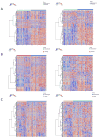Immune heterogeneity of glioblastoma subtypes: extrapolation from the cancer genome atlas
- PMID: 24409449
- PMCID: PMC3881271
- DOI: 10.1158/2326-6066.CIR-13-0028
Immune heterogeneity of glioblastoma subtypes: extrapolation from the cancer genome atlas
Abstract
Purpose: The molecular heterogeneity of glioblastoma has been well recognized and has resulted in the generation of molecularly defined subtypes. These subtypes (classical, neural, mesenchymal, and proneural) are associated with particular signaling pathways and differential patient survival. Less understood is the correlation between these glioblastoma subtypes with immune system effector responses, immune suppression and tumor-associated and tumor-specific antigens. The role of the immune system is becoming increasingly relevant to treatment as new agents are being developed to target mediators of tumor-induced immune suppression which is well documented in glioblastoma.
Experimental design: To ascertain the association of antigen expression, immune suppression, and effector response genes within glioblastoma subtypes, we analyzed the Cancer Genome Atlas (TCGA) glioblastoma database.
Results: We found an enrichment of genes within the mesenchymal subtype that are reflective of anti-tumor proinflammatory responses, including both adaptive and innate immunity and immune suppression.
Conclusions: These results indicate that distinct glioma antigens and immune genes demonstrate differential expression between glioblastoma subtypes and this may influence responses to immune therapeutic strategies in patients depending on the subtype of glioblastoma they harbor.
Keywords: glioblastoma; immune activation; immune suppression; tumor antigens.
Conflict of interest statement
No potential conflicts of interest are disclosed.
Figures


Similar articles
-
Glioblastoma TCGA Mesenchymal and IGS 23 Tumors are Identifiable by IHC and have an Immune-phenotype Indicating a Potential Benefit from Immunotherapy.Clin Cancer Res. 2020 Dec 15;26(24):6600-6609. doi: 10.1158/1078-0432.CCR-20-2171. Epub 2020 Sep 30. Clin Cancer Res. 2020. PMID: 32998960
-
Unique genome-wide map of TCF4 and STAT3 targets using ChIP-seq reveals their association with new molecular subtypes of glioblastoma.Neuro Oncol. 2013 Mar;15(3):279-89. doi: 10.1093/neuonc/nos306. Epub 2013 Jan 7. Neuro Oncol. 2013. PMID: 23295773 Free PMC article.
-
Identification of Tumor Antigens and Immune Subtypes of Glioblastoma for mRNA Vaccine Development.Front Immunol. 2022 Feb 2;13:773264. doi: 10.3389/fimmu.2022.773264. eCollection 2022. Front Immunol. 2022. PMID: 35185876 Free PMC article.
-
Stem cell signature in glioblastoma: therapeutic development for a moving target.J Neurosurg. 2015 Feb;122(2):324-30. doi: 10.3171/2014.9.JNS132253. Epub 2014 Nov 14. J Neurosurg. 2015. PMID: 25397368 Review.
-
Novel mechanisms and approaches in immunotherapy for brain tumors.Discov Med. 2015 Jul-Aug;20(108):7-15. Discov Med. 2015. PMID: 26321082 Review.
Cited by
-
The two-sided battlefield of tumour-associated macrophages in glioblastoma: unravelling their therapeutic potential.Discov Oncol. 2024 Oct 25;15(1):590. doi: 10.1007/s12672-024-01464-5. Discov Oncol. 2024. PMID: 39453528 Free PMC article. Review.
-
Advances in immunotherapy for glioblastoma multiforme.Front Immunol. 2022 Oct 12;13:944452. doi: 10.3389/fimmu.2022.944452. eCollection 2022. Front Immunol. 2022. PMID: 36311781 Free PMC article. Review.
-
Tipping a favorable CNS intratumoral immune response using immune stimulation combined with inhibition of tumor-mediated immune suppression.Oncoimmunology. 2015 Dec 21;5(5):e1117739. doi: 10.1080/2162402X.2015.1117739. eCollection 2016 May. Oncoimmunology. 2015. PMID: 27467917 Free PMC article.
-
Creation of an NCI comparative brain tumor consortium: informing the translation of new knowledge from canine to human brain tumor patients.Neuro Oncol. 2016 Sep;18(9):1209-18. doi: 10.1093/neuonc/now051. Epub 2016 May 14. Neuro Oncol. 2016. PMID: 27179361 Free PMC article. Review.
-
A Radiosensitivity Gene Signature and PD-L1 Status Predict Clinical Outcome of Patients with Glioblastoma Multiforme in The Cancer Genome Atlas Dataset.Cancer Res Treat. 2020 Apr;52(2):530-542. doi: 10.4143/crt.2019.440. Epub 2019 Nov 20. Cancer Res Treat. 2020. PMID: 31801317 Free PMC article.
References
-
- Heimberger AB, Abou-Ghazal M, Reina-Ortiz C, Yang DS, Sun W, Qiao W, et al. Incidence and prognostic impact of FoxP3+ regulatory T cells in human gliomas. Clin Cancer Res. 2008;14:5166–72. - PubMed
-
- Phillips HS, Kharbanda S, Chen R, Forrest WF, Soriano RH, Wu TD, et al. Molecular subclasses of high-grade glioma predict prognosis, delineate a pattern of disease progression, and resemble stages in neurogenesis. Cancer Cell. 2006;9:157–73. - PubMed
Publication types
MeSH terms
Substances
Grants and funding
LinkOut - more resources
Full Text Sources
Other Literature Sources
Medical

